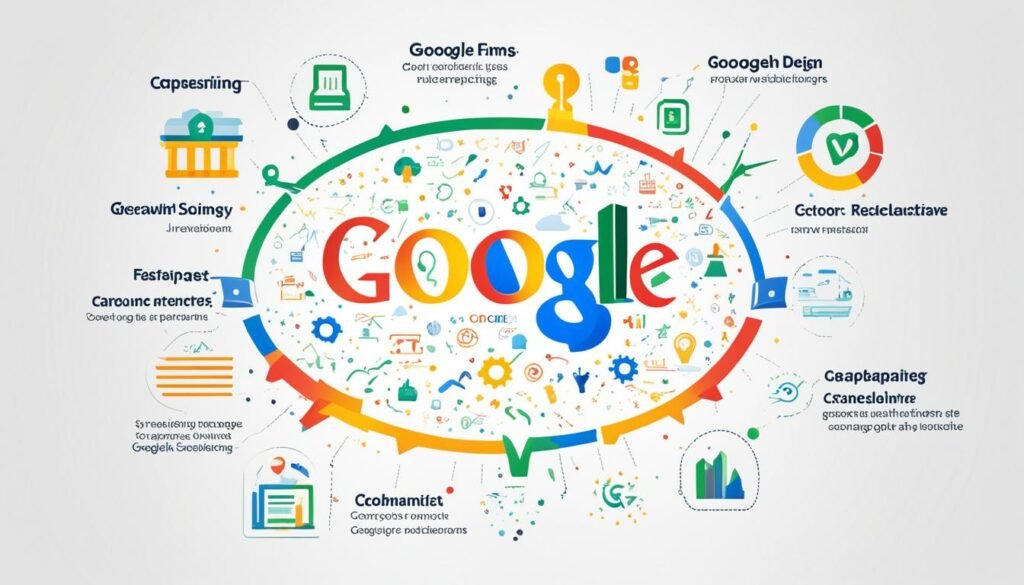In the fast-changing world of SEO, knowing how Google ranks websites is key. The latest data shows that content quality, backlinks, technical SEO, and keyword use are top google ranking factors. This article will explore these factors, their importance, and how to make your site better.
Key Takeaways
- Content quality is the top-ranking factor, accounting for 21% of the algorithm.
- Backlinks remain an essential factor, making up 13% of the algorithm.
- Technical SEO, including mobile-friendliness and site speed, are crucial for ranking.
- Keyword optimization, such as keywords in title tags and header tags, still affects rankings.
- Emerging factors like trustworthiness and user engagement are becoming more important.
The Top 8 Factors
Google rankings are influenced by a few key factors. These include content quality, backlinks, technical SEO, and keyword optimization. Each of these elements is vital for a website’s search engine visibility. Knowing their importance is key for any SEO strategy to boost search engine ranking.
Content Quality
Content quality is the top ranking factor for Google. The search engine looks for content that is informative, relevant, and engaging. Sites with deep, valuable information do well. On the other hand, thin or low-quality content often ranks poorly.
Backlinks
Backlinks are like “votes of confidence” from other websites. They boost a site’s authority and relevance. The quality and relevance of these links matter a lot. Google checks the link profile to see if a website is trustworthy and an expert in its field.
Technical SEO
Technical SEO factors, like website speed and mobile-friendliness, are important. They affect the user experience and show search engines that a site is well-optimized. This means it deserves better visibility.
Keyword Optimization
Keyword optimization helps search engines understand a webpage’s relevance. Using keywords in titles, descriptions, and content aligns with what users are searching for. This can help a site rank higher on the search engine results page (SERP).
Mastering these top 8 ranking factors is key for any website wanting to improve its Google ranking and get more organic traffic. Focusing on content quality, backlinks, technical SEO, and keyword optimization can help businesses and website owners succeed online.

Domain Factors
Domain factors are key in Google rankings. Domain age used to be seen as a trust signal, but Google’s John Mueller says it doesn’t affect rankings. Yet, having a keyword in the domain can show relevance. Also, domains registered for longer times are seen as more trustworthy by Google.
Domain Age
Many thought domain age was a big deal for rankings, but Google says it’s not. In 2020, Google said domain age doesn’t really matter for search results. Now, it’s more about the domain’s trustworthiness, shown through its content, backlinks, and user interaction.
Keyword in Top Level Domain
Putting a keyword in the top-level domain (TLD) can hint at relevance to search engines. But, this trick isn’t as powerful as it used to be. Google’s algorithms now look deeper at a website’s quality and relevance.
Domain Registration Length
Domains registered for a long time are seen as more trustworthy by Google. This is because they’re less likely to be involved in spam or bad activities. While it’s not a big ranking factor, it helps with a website’s credibility and authority.
| Domain Factor | Impact on Google Rankings |
|---|---|
| Domain Age | No longer a direct ranking factor, but can contribute to overall trustworthiness |
| Keyword in Top Level Domain | Provides a subtle relevancy signal, but diminished in importance over time |
| Domain Registration Length | Longer-registered domains are perceived as more trustworthy, but not a major ranking factor |

“Your choice of domain name can influence user experience and public image, but it does not directly impact Google ranking.”
Page-Level Factors
Google’s ranking algorithm looks at page-level factors to see how visible and successful a website is. These factors focus on individual webpages. They include things like optimizing title tags, meta descriptions, and header tags.
Keyword in Title Tag
The title tag is key for SEO on a webpage. It’s the main headline in search engine results. Having the main keyword in the title tag boosts a page’s content relevance and rankings.
Title Tag Starts with Keyword
Putting the keyword at the start of the title tag helps too. It makes it easier for search engines to see what the content is about. This improves the title tag optimization.
Keyword in Description Tag
The meta description tag doesn’t directly affect rankings but can boost the click-through rate (CTR). Adding the main keyword to the meta description makes the snippet more relevant and appealing. This leads to more traffic to the webpage.
Keyword in H1 Tag
The H1 tag is the main heading on a webpage. It’s a key relevancy signal for search engines. Using the keyword in the H1 tag strengthens the content’s topic and focus. This improves the on-page optimization.
| Page-Level Factor | Impact on SEO |
|---|---|
| Keyword in Title Tag | Improves content relevance and rankings |
| Title Tag Starts with Keyword | Enhances title tag optimization |
| Keyword in Description Tag | Increases click-through rate from SERP |
| Keyword in H1 Tag | Strengthens relevancy signals for search engines |
By focusing on these page-level factors, website owners can make their webpages clear and relevant to search engines. This boosts their on-page optimization and visibility in search results.
User Experience (UX)
In today’s digital world, user experience (UX) is key to a website’s success. Google, the top search engine, values UX highly. They aim to give users a smooth and satisfying experience to show the most relevant info.
Important UX factors include page speed, mobile-friendliness, and website usability. Google wants users to find what they need quickly and easily. So, sites that offer a great UX tend to rank better.
High bounce rates and low dwell time mean users leave quickly, showing a bad UX. But, more pages visited and click-through rates (CTR) mean users enjoy their visit, helping with rankings.
With over half of web traffic from mobiles, mobile-friendly design is vital. Google favors sites that work well on mobiles over those that don’t. This means a good mobile UX can boost rankings.
Using A/B testing and user personas helps improve UX. The EAT concept (Expertise, Authoritativeness, and Trustworthiness) from Google highlights the need for a rich, user-focused experience. This approach helps meet search intent and keeps users engaged.
In short, focusing on UX is vital for a good user experience and better search rankings. By improving page speed, mobile-friendliness, and usability, site owners can reach their audience more effectively.
Google ranking factor and it’s weightage
Knowing which Google ranking factors matter most is key for a good SEO plan. Google looks at over 200 factors, but some are more important for ranking a site.
Content quality is a big deal for Google. It wants content that’s thorough, trustworthy, and engaging. Things like how long people stay on a page and if they click on links help check if content is good.
Backlinks are also very important. They show a site is trusted and respected. Getting backlinks from reliable sources can really help a site rank better.
| Ranking Factor | Relative Weightage |
|---|---|
| Content Quality | 20-25% |
| Backlinks | 15-20% |
| Technical SEO | 10-15% |
| Keyword Optimization | 10-15% |
| Domain Factors | 5-10% |
| User Experience (UX) | 10-15% |
| On-Site Webspam Factors | 5-10% |
| Off-Site Webspam Factors | 5-10% |
| Core Web Vitals | 10-15% |
Remember, the importance of these factors can change as Google updates its rules. Keeping up with the latest algorithm updates and ranking signals is key. This helps in making a strong SEO strategy and keeping a good online presence.
“Prioritizing key ranking factors can impact around 90% of a website’s SEO success.”
On-Site Webspam Factors
Google looks at many factors to decide how to rank websites. They watch for on-site webspam that hurts the user experience and content relevance. Key issues are keyword stuffing and cloaking.
Keyword Stuffing
Keyword stuffing means using too many keywords in a webpage. It’s a way some try to trick Google, but it’s seen as spam. Sites that do this can get hit with big penalties, like lower rankings or being removed from search results.
Cloaking
Cloaking shows different content to search engines than what users see. This breaks Google’s rules and can cause big ranking drops or removal from search results. It hurts the trust search engines aim to keep, making the search experience less reliable.
To stay visible online and avoid Google penalties, it’s key to follow Google’s guidelines. Focus on making content that’s valuable and focused on users. Avoiding on-site webspam helps build a strong, trusted online brand that both search engines and users will like.
Off-Site Webspam Factors
Link building is key to Search Engine Optimization (SEO), but Google watches for off-site webspam. This includes using paid links. Buying backlinks or joining link schemes can lead to penalties. A natural, high-quality link profile is vital for success in search results.
Known Paid Links
Google values the quality and truth of backlinks to a website. The search engine has smart algorithms to spot and punish sites that buy links or use other bad link tactics. These “known paid links” can really hurt a site’s rankings, seen as trying to cheat and get an unfair edge.
To dodge Google’s penalties, focus on building real, quality backlinks with white-hat strategies. This means making content worth sharing, connecting with influencers, and joining online groups. A natural, varied link profile helps improve search visibility and avoids off-site webspam risks.
“Focusing on quality over quantity when it comes to backlinks is the key to long-term success in search engine optimization.”
In short, off-site webspam, like using paid links, can badly hurt a website’s rankings. Knowing and avoiding these issues helps build a lasting, effective link profile that meets Google’s standards.
Core Web Vitals
Google’s Core Web Vitals are now key in how websites rank. They look at how fast a site loads, how interactive it is, and how stable it looks. SEO experts and website owners focus on these to improve user experience (UX).
Malte Ubl, a former Google leader, helped start the “Page Experience” system. This system uses Core Web Vitals to rank sites. Now, Google’s algorithm checks sites based on these metrics, using real data, not just scores.
Google uses Largest Contentful Paint (LCP), Interaction to Next Paint (INP), and Cumulative Layout Shift (CLS) for ranking. INP replaced First Input Delay (FID) on March 12, 2024. This shows Google’s ongoing work to better measure user experience.
Google looks at Core Web Vitals over a 28-day period and averages the scores. This way, sites are judged on their long-term performance, not just one day’s speed.
Tools like Vercel’s Speed Insights give real-time Core Web Vitals data. This helps spot and fix performance problems quickly. The Chrome User Experience Report (CrUX) is also a key source for these metrics.
As Core Web Vitals become more important, making your site fast, smooth, and stable is key for SEO. This approach helps sites rank better on Google and get more visibility in search results.
Backlink Factors
Google’s ranking algorithms pay a lot of attention to your website’s backlink quality and relevance. High-quality backlinks from reputable sites show trust and credibility. But, low-quality or off-topic backlinks can hurt your site’s rankings.
Quality of Backlinks
High-quality backlinks are key. They come from respected, high-authority sites that match your website’s topic. These links show your content is valuable and trustworthy. But, links from low-quality or unrelated sites can harm your backlink quality and link profile.
Relevance of Linking Sites
The sites that link to you matter a lot. Google values link relevance in your backlink profile. Links from sites that match your content and industry are more useful. Building a diverse, natural, and relevant backlink profile is key for good off-site optimization and SEO success.
| Ranking Factor | Importance | Trend |
|---|---|---|
| Backlink Quality | 13% | Decrease |
| Link Relevance | 13% | Stable |
| Link Profile Diversity | 3% | Increase |
“Developing a diverse, natural, and relevant backlink profile is crucial for sustainable off-site optimization and long-term SEO success.”
Conclusion
Understanding the key google ranking factors is crucial for better search engine optimization and more organic traffic growth. Focus on making your content better, getting strong backlinks, and improving technical SEO. Also, make sure your site is easy for users to navigate.
It’s important to keep up with changes in Google’s algorithms. This means updating your website optimization strategies regularly. By doing this, you can improve your site’s visibility in search results and connect with more people.
A complete strategy that covers all google ranking factors and SEO best practices is key. This approach helps you grow your organic traffic over time. It’s the way to succeed in the competitive online world.

